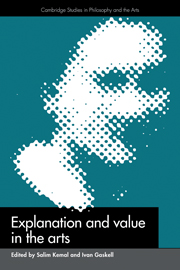Book contents
- Frontmatter
- Contents
- List of contributors
- Editors' acknowledgments
- 1 Interests, values, and explanations
- 2 Fiction and reality in painting
- 3 Franz Kafka: the necessity for a philosophical interpretation of his work
- 4 On relocating ethical criticism
- 5 Explanation and value: what makes the visual arts so different, so appealing?
- 6 Is art history?
- 7 Objectivity and valuation in contemporary art history
- 8 Fullness and parsimony: notes on creativity in the arts
- 9 Principles of a sociology of cultural works
- 10 Althusser and ideological criticism of the arts
- 11 Film, rhetoric, and ideology
- Index
6 - Is art history?
Published online by Cambridge University Press: 24 February 2010
- Frontmatter
- Contents
- List of contributors
- Editors' acknowledgments
- 1 Interests, values, and explanations
- 2 Fiction and reality in painting
- 3 Franz Kafka: the necessity for a philosophical interpretation of his work
- 4 On relocating ethical criticism
- 5 Explanation and value: what makes the visual arts so different, so appealing?
- 6 Is art history?
- 7 Objectivity and valuation in contemporary art history
- 8 Fullness and parsimony: notes on creativity in the arts
- 9 Principles of a sociology of cultural works
- 10 Althusser and ideological criticism of the arts
- 11 Film, rhetoric, and ideology
- Index
Summary
It comes as no surprise to a student of art and its history these days to open a book on Italian painting and find an extensive discussion of barrel-gauging, or to turn to a study of Courbet and find many pages devoted to a detailed account of radicalism among French peasants in 1849 and 1850. The books by Michael Baxandall and T. J. Clark to which I am referring are not eccentric texts but among the most inventive and interesting studies of art written in recent years. Distinctive though their emphases are, these writers share a commitment to consider the work of art as a “piece of history.” Baxandall argues that we should consider Piero della Francesca's pictorial engagement with solid geometric forms in terms of the accepted fifteenth-century training in commercial mathematics. Similarly, Clark argues that an attention to the situation of French rural society enables us to understand the presence (in style, but also inseparably in content) of Courbet's great works of 1849–50. I have chosen these two books as among the most rigorously argued of what is indeed a great number of such studies. It is a fashion by now, and almost established as one of the acceptable tools of the art historical trade. The new art history was announced in the title of a series of book-length studies of individual works initiated in the 1960s – Art in Context. The traditional mode of art history is represented by Pevsner's multivolumed History of Art, which began appearing in the 1950s and considers the history of art period by period, and country by country.
- Type
- Chapter
- Information
- Explanation and Value in the Arts , pp. 109 - 126Publisher: Cambridge University PressPrint publication year: 1993

